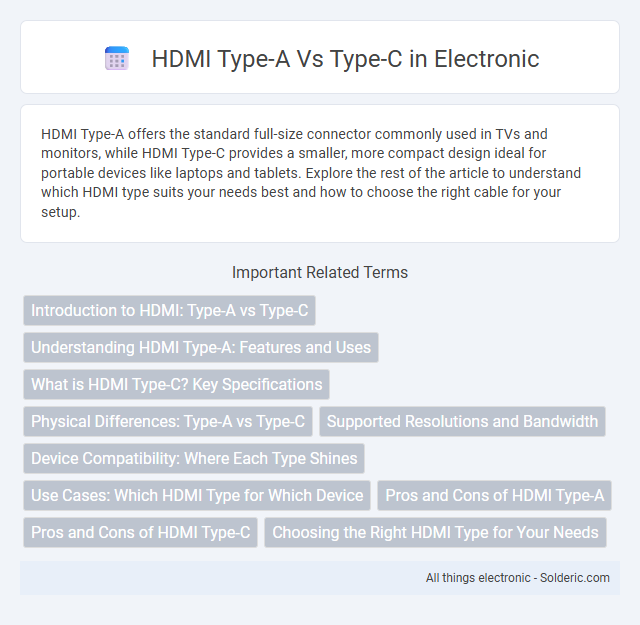HDMI Type-A offers the standard full-size connector commonly used in TVs and monitors, while HDMI Type-C provides a smaller, more compact design ideal for portable devices like laptops and tablets. Explore the rest of the article to understand which HDMI type suits your needs best and how to choose the right cable for your setup.
Comparison Table
| Feature | HDMI Type-A | HDMI Type-C |
|---|---|---|
| Connector Size | 13.9 mm x 4.45 mm | 10.42 mm x 2.42 mm |
| Use Case | Standard TVs, monitors, projectors | Portable devices, tablets, cameras |
| Compatibility | Common HDMI ports on home electronics | Backward compatible via adapters with Type-A |
| Video Bandwidth | Up to 18 Gbps (HDMI 2.0) | Up to 18 Gbps (HDMI 2.0) |
| Audio Support | Supports multi-channel audio | Supports multi-channel audio |
| Durability | Standard durability, less suited for mobile use | Designed for frequent plugging, better for mobile use |
| Pin Count | 19 pins | 19 pins |
| Reversibility | Non-reversible | Non-reversible |
Introduction to HDMI: Type-A vs Type-C
HDMI Type-A is the standard full-sized connector commonly used on most TVs, monitors, and home theater devices, offering stable and high-definition video and audio transmission. HDMI Type-C, also known as mini HDMI, is a smaller variant designed for portable devices like cameras, tablets, and laptops, providing the same high-quality output in a compact form factor. Understanding the differences between HDMI Type-A and Type-C can help you select the right cable or adapter for your multimedia needs and ensure optimal connectivity.
Understanding HDMI Type-A: Features and Uses
HDMI Type-A is the standard full-size HDMI connector widely used for transmitting high-definition video and audio between devices like TVs, gaming consoles, and Blu-ray players. It supports resolutions up to 4K UHD at 60Hz and features 19 pins for robust signal transmission. Type-A connectors are known for their durability and compatibility with a broad range of consumer electronics, making them the go-to choice for home entertainment systems.
What is HDMI Type-C? Key Specifications
HDMI Type-C, also known as HDMI Mini, is a compact connector designed for portable devices such as tablets, smartphones, and laptops, providing the same high-definition video and audio capabilities as the standard HDMI Type-A. It supports 4K resolution at 60Hz, HDR video, and multi-channel audio formats, adhering to HDMI 2.0 specifications for enhanced multimedia performance. The Type-C connector measures approximately 10.42mm by 2.42mm, making it ideal for slim devices without compromising on signal quality or bandwidth.
Physical Differences: Type-A vs Type-C
HDMI Type-A features a larger, rectangular 19-pin connector measuring approximately 13.9mm by 4.45mm, designed for standard-sized devices such as TVs and monitors. In contrast, HDMI Type-C, also known as Mini HDMI, is significantly smaller at about 10.42mm by 2.42mm, with a more compact 19-pin configuration tailored for portable devices like cameras and tablets. The distinct physical size and shape of Type-C connectors enhance portability without sacrificing compatibility with the same high-definition video and audio signals supported by Type-A.
Supported Resolutions and Bandwidth
HDMI Type-A supports resolutions up to 4K at 60Hz with a maximum bandwidth of 18 Gbps, ideal for most standard HDTVs and monitors. HDMI Type-C, also known as Mini HDMI, maintains the same high-resolution support and bandwidth capabilities but offers a smaller form factor, making it suitable for compact devices like cameras and tablets. Your choice depends on device compatibility, ensuring optimal video quality without sacrificing performance.
Device Compatibility: Where Each Type Shines
HDMI Type-A is widely compatible with most televisions, monitors, gaming consoles, and home theater systems due to its standard full-sized connector, making it ideal for stationary setups. HDMI Type-C, also known as Mini HDMI, is designed for compact devices like cameras, tablets, and ultrabooks where space savings are essential. Devices with HDMI Type-C benefit from maintaining high-definition video and audio output while supporting portability and smaller form factors.
Use Cases: Which HDMI Type for Which Device
HDMI Type-A, the standard full-size connector, is commonly used for TVs, monitors, and gaming consoles due to its robust compatibility and durable design. HDMI Type-C, also known as Mini HDMI, is ideal for compact devices such as DSLR cameras, tablets, and ultra-thin laptops where space saving is crucial without compromising on high-definition video and audio output. Selecting the appropriate HDMI type ensures optimal connectivity based on device size, portability, and video resolution requirements.
Pros and Cons of HDMI Type-A
HDMI Type-A is widely recognized for its compatibility with most TVs, monitors, and home theater systems, providing high-definition video and audio over a single cable, which simplifies connectivity. Its large connector size ensures durability and a firm connection but can be cumbersome for smaller devices, making it less ideal for ultra-compact gadgets and modern smartphones. However, the extensive support for 4K and 8K resolutions with HDMI Type-A makes it a reliable choice for high-performance multimedia setups.
Pros and Cons of HDMI Type-C
HDMI Type-C offers a compact design ideal for slim devices like smartphones and tablets, supporting 4K resolution and high-speed data transfer through a reversible connector that enhances user convenience. However, it may require adapters for compatibility with standard HDMI Type-A ports, potentially limiting direct connectivity with traditional displays and increasing setup complexity. The smaller form factor benefits portable electronics but can impose constraints on cable durability and maximum length compared to the robust Type-A standard.
Choosing the Right HDMI Type for Your Needs
HDMI Type-A, the standard full-sized connector, is ideal for TVs, monitors, and home theater systems due to its robust design and widespread compatibility. HDMI Type-C, also known as Mini HDMI, suits compact devices like cameras, tablets, and laptops, offering the same high-definition video and audio quality in a smaller form factor. Selecting the right HDMI type depends on device compatibility and portability requirements to ensure seamless connectivity and optimal performance.
HDMI Type-A vs Type-C Infographic

 solderic.com
solderic.com